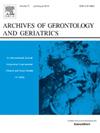EFFECTS OF SIBERIAN GINSENG (ELEUTHEROCOCCUS SENTICOSUS MAXIM.) ON ELDERLY QUALITY OF LIFE: A RANDOMIZED CLINICAL TRIAL
IF 3.5
3区 医学
Q2 GERIATRICS & GERONTOLOGY
引用次数: 0
西伯利亚人参对老年人生活质量的影响:随机临床试验。
一种不明确的疲劳和虚弱的感觉常常迫使老年病人要求任何形式的帮助,甚至是没有受过医学训练的人。传统中医认为西伯利亚人参可以作为一种安全的“适应性”物质。因此,我们的目的是测试中期刺棘球菌的效果。老年人健康相关生活质量(HRQOL)的管理。20名老年高血压患者和数字化志愿者(年龄>/= 65岁)以双盲方式随机分配给刺蒺藜干提取物300 mg/d (n = 10)或安慰剂(n = 10),为期8周。使用经过验证的一般健康状况问卷-36健康调查版本2 (SF-36v2),在基线、4周和8周时获取HRQOL。两组间基线人口统计学和SF-36v2评分无显著差异。在每次访问时,进行数字血症和血压水平的控制。治疗4周后,被随机分配到感觉性肠杆菌组的患者在社会功能量表上得分较高(p = 0.02);这些差异并没有持续到8周的时间点。两组患者均未观察到不良事件。两组在血压控制和数字血症方面均无显著差异。与服用安慰剂的受试者相比,服用刺毛杆菌的受试者(70%)更有可能表示他们接受了积极治疗(20%;P < 0.05)。综上所述,在4周的治疗后,尽管这些差异随着持续使用而减弱,但感知草安全地改善了心理健康和社会功能的某些方面。
本文章由计算机程序翻译,如有差异,请以英文原文为准。
求助全文
约1分钟内获得全文
求助全文
来源期刊
CiteScore
7.30
自引率
5.00%
发文量
198
审稿时长
16 days
期刊介绍:
Archives of Gerontology and Geriatrics provides a medium for the publication of papers from the fields of experimental gerontology and clinical and social geriatrics. The principal aim of the journal is to facilitate the exchange of information between specialists in these three fields of gerontological research. Experimental papers dealing with the basic mechanisms of aging at molecular, cellular, tissue or organ levels will be published.
Clinical papers will be accepted if they provide sufficiently new information or are of fundamental importance for the knowledge of human aging. Purely descriptive clinical papers will be accepted only if the results permit further interpretation. Papers dealing with anti-aging pharmacological preparations in humans are welcome. Papers on the social aspects of geriatrics will be accepted if they are of general interest regarding the epidemiology of aging and the efficiency and working methods of the social organizations for the health care of the elderly.

 求助内容:
求助内容: 应助结果提醒方式:
应助结果提醒方式:


